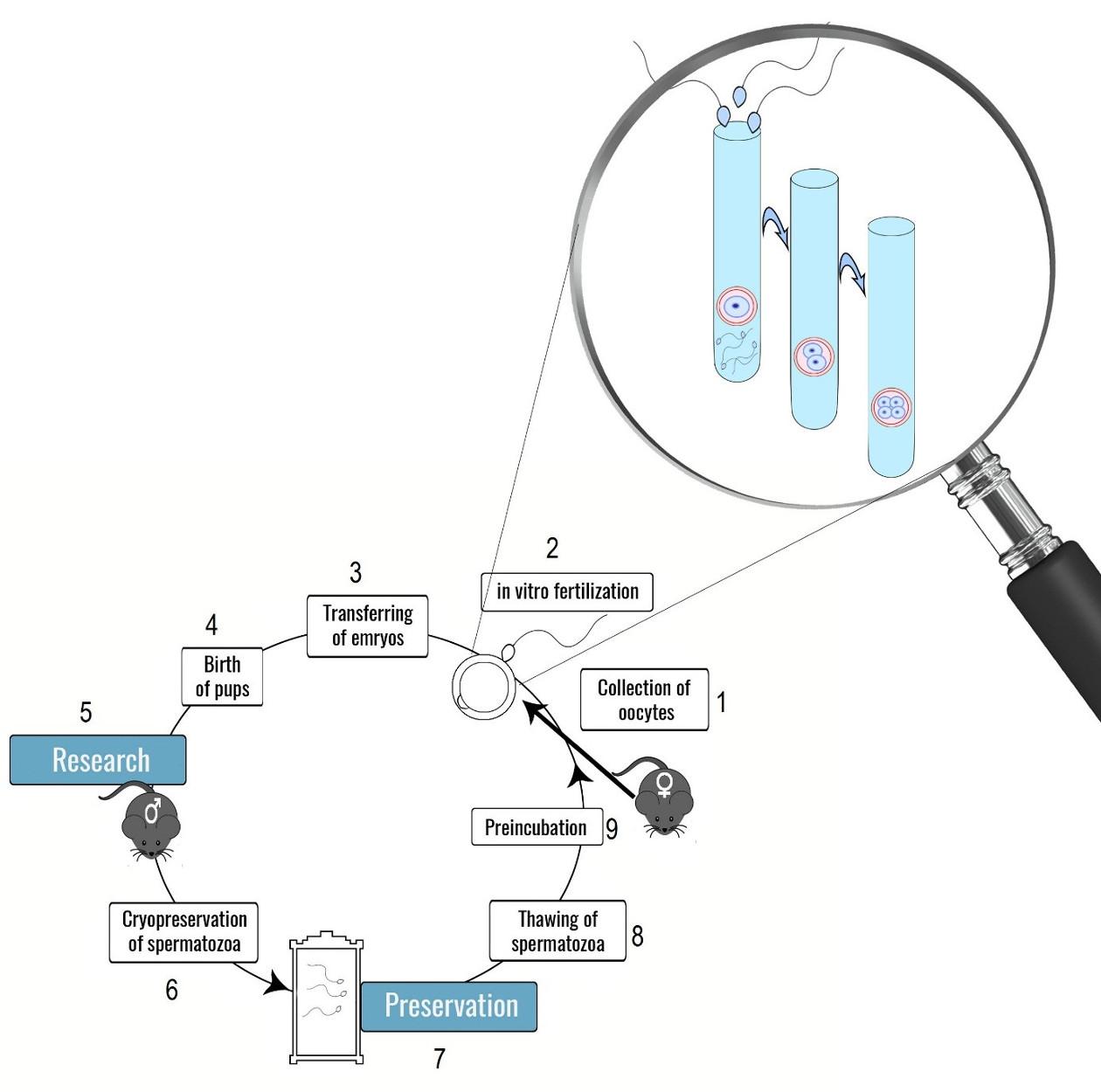In vitro fertilization - Info
In Vitro fertilization
Products
Definition
In Vitro fertilization (abbr. IVF, lat. for “in tube”) describes a method of extracorporal, spontaneous fusion of oocytes and spermatozoa in a reaction tube. To preserve and incubate the oocytes and spermatozoa the appropriate media have to be used. Afterwards the growing Embryo will be transplanted into the cavity of the uterus.
 Figure 1: Theoretical procedure of a new breeding line. 1= Collection of oocytes, 2= Fusion of spermatozoa and oocytes In Vitro, 3= Transfer of embryos into uterus, 4= Birth of pups, 5= Desired line for research, 6= Cryopreservation of spermatozoa, 7= Preservation in appropriate medium, 8= Thawing of spermatozoa, 9= Preincubation
Figure 1: Theoretical procedure of a new breeding line. 1= Collection of oocytes, 2= Fusion of spermatozoa and oocytes In Vitro, 3= Transfer of embryos into uterus, 4= Birth of pups, 5= Desired line for research, 6= Cryopreservation of spermatozoa, 7= Preservation in appropriate medium, 8= Thawing of spermatozoa, 9= PreincubationHow does In Vitro fertilization work?
IVF starts with a hormonally induced egg production. A lot of oocytes mature artificially. Afterwards a superovulation is induced by another hormone therapy. With the help of a method called follicle puncture the oocytes are retrieved from the cavity of the uterus and transferred into an appropriate medium. Oocytes and spermatozoa are brought together which results in spontaneous fusion of both. If fertilization was successful the embryos are transferred back into the cavity of the uterus.
Application
For everyday life in laboratories the breeding of mice lines which secrete the wanted antibody or possess a certain gene defect (mutants) are essential. To avoid natural reproduction cycles IVF is indispensable. On the one hand a lot of oocytes can be artificially fertilized and on the other hand frozen oocytes, spermatozoa or even embryos can be recovered and grow In Vitro. The embryos can be transferred into a surrogate mother which makes continuous colony expansion possible. What sounds theoretically easy is often practically difficult. It is not uncommon for spermatozoa and oocytes to be defective after cryopreservation because of crystallization or lead to less fertilization rates. To put things right the use of certain media can help to recover oocytes and spermatozoa after cryopreservation.
Products of COSMO BIO CO. LTD
The corporation is advertising a medium called FERTIUP which promises fertilization rates over 30%. While conventional methods only have rates of 5-15% COSMO BIO CO. LTD. even goes further and assures a fertilization rate of over 80% if CARD MEDIUM is added to FERTIUP. A drastic rise in fertilization rates leads to less labor and less costs. Furthermore it can be used for efficient production of difficult breeding lines.
Another problem is the transport of mice lines. While transporting living animals the risk of disease transfer is always a possibility. Additionally it is not uncommon for rodents especially transgenic mice to escape while transport which can lead to trouble with authorities. Instead of transporting the whole mice line only the Cauda epididymides will be delivered. No transfer of diseases, no escapes and substantially less space is needed for transport. All in all the costs can be reduced dramatically.



